Health Effects of Diesel and Gasoline Fuels
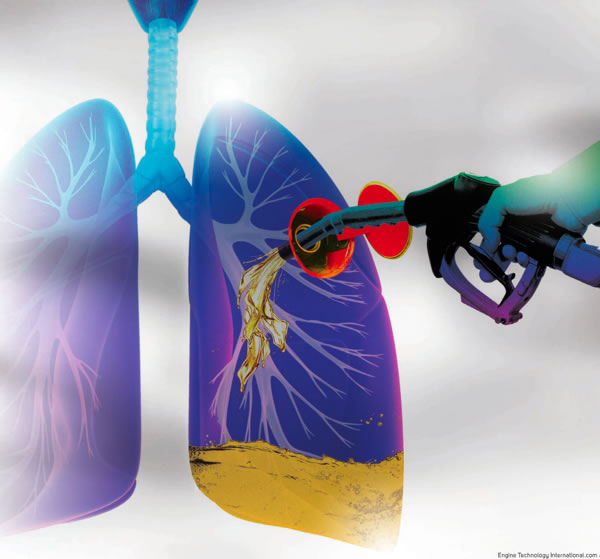 Both gasoline and diesel fuel result in harmful emissions, emitted in harmful amounts. Harmful to your heath. We will discuss the different issues with each of them, and finally show you that using alcohol fuels (ethanol and methanol, and blends of both of them) can be used to eliminate the need of diesel and remove the worst chemicals in gasoline (benzene and lead).
Both gasoline and diesel fuel result in harmful emissions, emitted in harmful amounts. Harmful to your heath. We will discuss the different issues with each of them, and finally show you that using alcohol fuels (ethanol and methanol, and blends of both of them) can be used to eliminate the need of diesel and remove the worst chemicals in gasoline (benzene and lead).
1. Diesel Fuel Issues
The link between diesel exhaust and cancer is nothing new. In fact, back in 1988 the World Health Organization’s (WHO) International Agency for Research on Cancer (IARC) classified diesel exhaust as ‘probably carcinogenic in humans’. But on June 12, 2012 the IARC went one step further, announcing a reclassification to ‘carcinogenic in humans’, with its advisory committee concluding that diesel exhaust is a cause of lung cancer, and causes an increased risk of bladder cancer. The story is just below, but first we review what diesel fuel is.
Diesel is a type of fuel derived from crude oil. Large engines, including those used in many trucks, buses, trains, construction and farm equipment, generators, ships, and in some cars, run on diesel fuel. The exhaust from diesel engines is made up of 2 main parts: gases and soot. Each of these, in turn, is made up of many different substances. The gas portion of diesel exhaust is mostly carbon dioxide, carbon monoxide, nitric oxide, nitrogen dioxide, sulfur oxides, and hydrocarbons, including polycyclic aromatic hydrocarbons (PAHs). The soot (particulate) portion of diesel exhaust is made up of particles such as carbon, organic materials (including PAHs), and traces of metallic compounds. Both the gases and the soot of diesel exhaust contain PAHs. Exposure to diesel exhaust is widespread in the modern world. Exhaust from diesel engines brings a complex mixture of soot and gases to roadways, cities, farms, and other places. Health concerns about diesel exhaust relate not only to cancer, but also to other health problems such as lung and heart diseases.
1.1. Introduction to health problems - WHO declares diesel emissions carcinogenic
June 13, 2012, on page A8 of the New York edition of the NYT.
Diesel fumes cause lung cancer, the World Health Organization (WHO) declared Tuesday, and experts said they were more carcinogenic than secondhand cigarette smoke. The W.H.O. decision, the first to elevate diesel to the “known carcinogen” level, may eventually affect some American workers who are heavily exposed to exhaust. It is particularly relevant to poor countries, where trucks, generators, and farm and factory machinery routinely belch clouds of sooty smoke and fill the air with sulfurous particulates. The United States and other wealthy nations have less of a problem because they require modern diesel engines to burn much cleaner than they did even a decade ago. Most industries, like mining, already have limits on the amount of diesel fumes to which workers may be exposed. The medical director of the American Cancer Society praised the ruling by the W.H.O.’s International Agency for Research on Cancer, saying his group “has for a long time had concerns about diesel.” The cancer society is likely to come to the same conclusion the next time its scientific committee meets, said the director, Dr. Otis W. Brawley. “I don’t think it’s bad to have a diesel car,” Dr. Brawley added. “I don’t think it’s good to breathe its exhaust. I’m not concerned about people who walk past a diesel vehicle, I’m a little concerned about people like toll collectors, and I’m very concerned about people like miners, who work where exhaust is concentrated.”
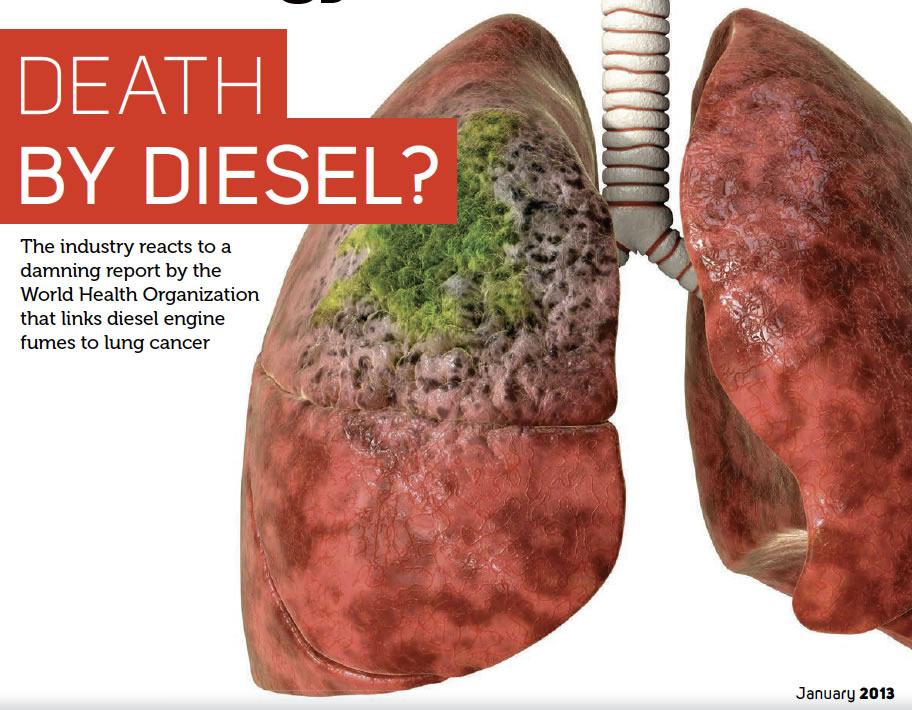
Debra T. Silverman, a cancer researcher for the United States government who headed an influential study published in March that led to Tuesday’s decision, said she was “totally in support” of the W.H.O. ruling and expected that the government would soon follow suit in declaring diesel exhaust a carcinogen. Three separate federal agencies already classify diesel exhaust as a “likely carcinogen,” a “potential occupational carcinogen” or “reasonably anticipated to be a human carcinogen.” Dr. Silverman, chief of environmental epidemiology for the National Cancer Institute, said her study of 50 years of exposure to diesel fumes by 12,000 miners showed that nonsmoking miners who were heavily exposed to diesel fumes for years had seven times the normal lung cancer risk of nonsmokers. The W.H.O. decision was announced Tuesday in Lyon, France, after a weeklong scientific meeting. It also said diesel exhaust was a possible cause of bladder cancer. Diesel exhaust now shares the W.H.O.’s Group 1 carcinogen status with smoking, asbestos, ultraviolet radiation, alcohol and other elements that pose cancer risks. Dr. Silverman said her research indicated that occupational diesel exposure was a far greater lung cancer risk than passive cigarette smoking, but a much smaller risk than smoking two packs a day. For years, the Environmental Protection Agency, the National Institute for Occupational Safety and Health, and the National Toxicology Program of the National Institutes of Health have rated diesel as a potential, not proven, carcinogen. The Diesel Technology Forum, which represents car and truck companies and others that make diesel engines, reacted cautiously to the W.H.O. ruling, noting that modern diesel engines used in the United States and other wealthy countries burn low sulfur fuel, so new trucks and buses emit 98 percent less particulates than old ones did and 99 percent less nitrogen oxide, which adds to ozone buildup. Allen Schaeffer, the forum’s executive director, said the studies considered by the W.H.O. “gave more weight to studies of exposure from technology from the 1950s, when there was no regulation.”
Ultra-low-sulfur fuel was introduced in 2000 and became mandatory in 2006, he said, and about a quarter of the American truck fleet was built after that mandate was passed. The government estimates that the entire truck fleet is replaced every 12 to 15 years, he added. Many studies have suggested links between diesel and lung cancer, but Dr. Silverman said hers was the first to measure with precision how much diesel exhaust each group of mineworkers was exposed to. Her study clearly established that the more a miner was exposed to diesel, the greater his cancer risk, she said. “Now we need to focus on managing exposures to diesel exhaust,” Dr. Brawley said.
The other side of the cancer story as seen by engine/auto manufacturers
Christian Chapelle, Peugeot’s president of powertrain argues that poor reporting of the study can be incredibly damaging for diesel technology. “The problem we have is that a lot of things are said through the media and it’s technically and factually wrong,” he says. The French engineer suggests that such studies can create “drama” for the diesel sector, even in its home market, Europe, let alone in key markets that diesel is desperately trying to break into, namely the USA. “Particulates are not good for the health – we know this and we don’t contest it. What we do contest is that our diesel technology is dirty; we can prove that with our modern diesels there are no more particulates. In fact, in terms of regulations, we are far ahead of the curve.”
Jürgen Döring, powertrain strategy manager at Mercedes-Benz, echoes such a claim. During a recent tech day event at the unveiling of the E 300 BlueTec, which marries the praised OM651 diesel to an electric motor that is fully parallel but technically separated from the IC engine by its own clutch, Döring told ETi, “At the end of the day, there are always risks with combustion – that’s expected – but our technology is state-of-the-art, meaning that the optimization of the engine itself is realized.”
According to Dario Sacco, Fiat’s EMEA powertrain engineering research and technology director, legislation as a result of WHO and other classifications has already played an active role in improving diesel emissions. He says, “In Europe, for example, the maximum mass of particulate matter has moved from the Euro 3 limit (set in 2000) of 50mg/km to 4.5mg/km. Moreover, starting from Euro 5B (2011), only for the diesel vehicles, a limit of 6*10^11 PN/km has been introduced.” But many manufacturers are already claiming to reach beyond these standards, with a source at BMW saying that its “fleet already fulfills all current emissions regulations or even exceeds expectations when offering Euro 6 diesel today – long before it will become statutory”. Tallaa also argues that while the IARC’s ruling may not seem relevant in the developed world because of existing legislation, it is still fundamental in driving global improvements and bringing older vehicles up to scratch.
“Given the lifecycle of diesel cars, an important proportion of the cars on our streets still don’t even comply with the current standards, even in the most advanced countries,” she says. Legislation in North America and Europe will be reviewed over the next year, and is likely to demand further reductions in particulate levels. Other markets such as Japan and Korea have also implemented legislation that mandates advanced emissions controls. And while China and India may currently lag behind, legislation is arguably ramping up more quickly than the speed of adoption seen in the Western world over the past 30 years, mainly due to the availability of technologies. Aside from this, a universal objective of legislators may be to ensure that new technology replaces old on-road technology as soon as possible. Andy Eastlake from the Low Carbon Vehicle Partnership believes the IARC’s work is of great importance, and shouldn’t be ignored. “It adds weight to the continuous development of even cleaner diesel engines. It also presents a significant opportunity for the transfer of the very sophisticated technology now applied to Euro 6 standard vehicles into a much wider range of applications,” he says.
Some final remarks on the cancer similarities
Experts at the World Health Organization (WHO) say diesel engine exhaust fumes belong in the same potentially deadly category as asbestos, arsenic and mustard gas. After a week-long meeting, the International Agency for Research on Cancer reclassified diesel exhausts from its group of probable carcinogens, to its group of substances that have definite links to cancer. It says diesel emissions cause lung cancer and increase the risk of bladder cancer. They say their decision was unanimous and based on "compelling" scientific evidence. The director of New York's Clean Fuels and Vehicles Project, Rich Kassel, has told CNN the WHO has confirmed what has been suspected for some time. "Anybody who lives in Beijing, Mexico, New York or any congested city has probably felt the feeling of holding their breath when the bus pulls away from the curb leaving you in a ... puff of black smoke," he said. "This study basically confirms that we're right to hold our breath when the bus pulls away."
1.2. Other health issues due to Particulates
We are all aware of the smoking diesels trucks that fill our highways.
The pollution that we care about from diesel - buses, trucks and other diesel engines - is technically called particulate matter. We all know it is soot. It's fine, fine particles that are small enough to get past our throat, past our lungs into the deepest part, the deepest of our lungs, where they trigger asthma attacks, bronchitis, emphysema, heart disease and now of course we've learned cancer."
The WHO has acknowledged tougher fuel regulation has led to improved diesel quality and trucks do not billow big clouds of soot so often anymore. But it says it is not yet clear whether these changes have reduced the risks. A map of the PM2.5 Mortality Risk in 2005 is shown below: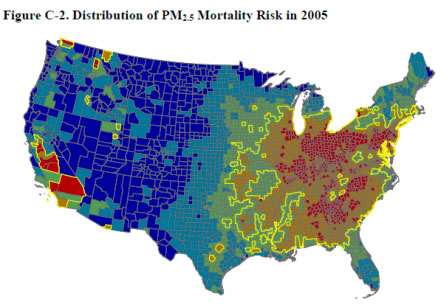
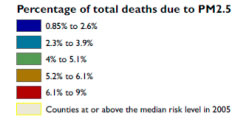
The Cancer Council's chief executive, Professor Ian Olver, says the WHO also has not confirmed what levels of exposure cause cancer. "Most of the data in the world relates to occupational exposure, such as diesel equipment in mines, or transport, particularly railway workers, exposed to diesel," he said. "So the first group that we ought to be looking at are those that [are exposed] to the heavy diesel output machinery." Professor Olver says there is no data available for the levels of exposure in cities. "The difficulty is that all the pollutants, whether it is a petrol engine or a diesel engine, are all mixed together and that is why the data upon which this was based had to be the more specialized sort of high-level exposure of various occupations," he said. Andrew Bourne has been in the diesel fuel injection industry for more than 30 years, and runs a diesel business in Toowoomba in Queensland. "We're certainly dealing with emissions every day," he said. "The machines that we see coming through our business have health problems with either the engine or the fuel system and as a result of that, often their emissions are one of the main telltales. Mr Bourne says the WHO's announcement is a good reminder. "Perhaps we might be more aware. We already do take measures to protect ourselves from those fumes," he said. "We direct exhaust fumes outside of our building through piping from the exhaust. Perhaps with these findings we might be a little more careful with making sure that we evacuate that gas more actively."
1.3. More detail on the diesel exhaust cancer studies
Researchers use 2 main types of studies to try to determine if a substance or exposure causes cancer. (A substance that causes cancer or helps cancer grow is called a carcinogen.) In studies done in the lab, animals are exposed to a substance (often in very large doses) to see if it causes tumors or other health problems. Researchers may also expose normal cells in a lab dish to the substance to see if it causes the types of changes that are seen in cancer cells. But it’s not always clear if the results from these types of studies will apply to humans. Another type of study looks at cancer rates in different groups of people. Such a study might compare the cancer rate in a group exposed to a substance versus either the cancer rate in a group not exposed to it, or the cancer rate in the general population. But studies in people can sometimes be hard to interpret, because there may be other factors affecting the results that are hard to account for. In most cases neither type of study provides definitive evidence on its own, so researchers usually look at both lab-based and human studies if they are available. Studying a substance like diesel exhaust can be even more complicated because it is actually a mixture of many chemicals. Therefore, researchers have to look at studies of the parts of diesel exhaust, such as soot and PAHs, as well as studies of diesel exhaust itself. On top of this, changes in diesel technology in recent decades have resulted in lower levels of soot (particles) in diesel exhaust. Studying diesel exhaust exposure from decades ago may not be the same as studying current exposures.
Studies done in the lab
In studies of cells done in lab dishes, diesel exhaust (as soot or chemical extracts) can cause changes in the cells’ DNA. These types of changes are usually needed for cancer to develop, although not all substances that cause DNA changes also cause cancer. Several studies have found that long-term, heavy exposure to diesel exhaust can cause lung cancer in lab animals such as rats.
Studies in people
It is not easy to study the possible health effects of diesel exhaust in people. First, it is often very hard to correctly define and measure the level of exposure. It can also be hard to account for the other cancer risk factors that people exposed to diesel exhaust might have, such as smoking.
Lung cancer
Lung cancer is the major cancer thought to be linked to diesel exhaust. Several studies of workers exposed to diesel exhaust have shown small but significant increases in risk of lung cancer. Men with the heaviest and most prolonged exposures, such as railroad workers, heavy equipment operators, miners, and truck drivers, have been found to have higher lung cancer death rates than unexposed workers. Although most studies have found a link between diesel exhaust exposure and lung cancer, some have not. Still, based on the number of people exposed at work, diesel exhaust may pose a substantial health risk. The possible link between lung cancer and exposure to diesel exhaust outside of the workplace has not been studied extensively.
Other cancers
Several studies have looked for possible links between diesel exhaust and other cancers, including cancers of the larynx (voice box), esophagus, stomach, and bladder. Studies have also looked for links to blood system cancers such as lymphomas and leukemias (including childhood leukemia). While some studies have found possible links, others have not. More research is needed to show if diesel exhaust exposure is linked to any of these other cancers.
What expert agencies say
Several national and international agencies study substances in the environment to determine if they can cause cancer. The American Cancer Society looks to these organizations to evaluate the risks based on evidence from laboratory, animal, and human research studies. Some of these expert agencies have classified diesel exhaust as to whether it can cause cancer, based largely on the possible link to lung cancer. The International Agency for Research on Cancer (IARC) is part of the World Health Organization (WHO). Its major goal is to identify causes of cancer. IARC classifies diesel engine exhaust as “carcinogenic to humans,” based on sufficient evidence that it is linked to an increased risk of lung cancer, as well as limited evidence linking it to an increased risk of bladder cancer. The National Toxicology Program (NTP) is formed from parts of several different US government agencies, including the National Institutes of Health (NIH), the Centers for Disease Control and Prevention (CDC), and the Food and Drug Administration (FDA). The NTP has classified exposure to diesel exhaust particulates as “reasonably anticipated to be a human carcinogen,” based on limited evidence from studies in humans and supporting evidence from lab studies. The US Environmental Protection Agency (EPA) maintains the Integrated Risk Information System (IRIS), an electronic database that contains information on human health effects from exposure to various substances in the environment. The EPA classifies diesel exhaust as “likely to be carcinogenic to humans.” The National Institute for Occupational Safety and Health (NIOSH) is part of the CDC that studies exposures in the workplace. NIOSH has determined that diesel exhaust is a “potential occupational carcinogen.” (For more information on the classification systems used by these agencies, see our document, Known and Probable Human Carcinogens.)
Does diesel exhaust cause any other health problems?
Diesel exhaust is a major part of outdoor air pollution. Diesel exhaust is believed to play a role in other health problems, such as eye irritation, headache, asthma and other lung diseases, heart disease, and possibly immune system problems.
Can I reduce my exposure to diesel exhaust?
Diesel exhaust can cause several health problems and can most likely increase the risk of lung cancer (and possibly other cancers), so it makes sense to lower your exposure to it whenever possible. However, since most people’s exposure comes from exhaust near highways and other roads, government regulations may be more effective in limiting exposure than individual choices.
At work
If you are exposed to diesel exhaust at work, there are ways to reduce or prevent exposures. Some of these measures can also help protect you from other chemical exposures that are likely to happen in the workplace. If you work in or around vehicles that run on diesel fuel, you might be able to limit the amount of time you spend near engines while they are running. Limiting the time spent near idling engines may help lower your exposure to fumes. Talk with your employer to be sure that you are protected adequately. Personal protective equipment, such as respirators, may be a key part of a workplace protective program. If needed, engineering changes, such as ventilating the exhaust away from where you breathe, can also be important. For more information on preventing or reducing workplace exposures at your job, consult your company’s safety and health manager. If needed, you can get additional assistance from the Occupational Safety & Health Administration (OSHA), the government agency responsible for enforcing workplace safety.
Where you live and play
If you are exposed to diesel exhaust fumes in your environment, you can take some of the same precautions. For example, try to avoid or limit spending time near large sources of diesel exhaust, such as near trucks and buses. Commuting to and from work is a potential source of diesel exhaust exposure for many people, whether using a car or some type of public transportation. For some people, working from home (telecommuting or teleworking) may be an option to lower their exposure, as well as to save money on commuting expenses. On a governmental level, regulations such as the Clean Air Act and programs such as the EPA’s National Clean Diesel Campaign are designed to reduce diesel emissions from trucks and other large engines, lowering public exposure to diesel exhaust. Another important program is Clean School Bus USA. Children can be exposed to diesel exhaust during school bus travel or when standing near running school buses outside of school. Clean School Bus USA brings together partners from business, education, transportation, and public-health organizations to reduce children’s exposure to bus-related air pollutants by aiming to: Reduce unnecessary school bus idling Replace older buses with newer, less-polluting buses Upgrade existing buses with technologies to reduce their emissions
Additional resources
More information from your American Cancer Society We have some related information that may also be helpful to you. These materials may be ordered from our toll-free number, 1-800-227-2345. The above paragraphs are from the American Cancer Society Website:http://www.cancer.org/cancer/cancercauses/othercarcinogens/pollution/diesel-exhaust.
1.4. The NOx emissions
NOx is both an air pollution and a greenhouse gas issue. Nitrogen oxides (NOx ) lead to acid rain and contribute to unhealthy ground-level ozone and smog, often leading to severe respiratory problems among affected communities. Diesel engines produce unacceptably high levels of NOx at high loads, and NOx from nonroad diesel engines represents an increasing percentage of the environmental pollution in nonattainment regions (areas that do not meet primary environmental standards), where more than 90 million Americans live. Economical, easy-tointegrate solutions are needed to meet the NOx reduction goals of the Clean Air Act.
Historically diesel have been really large contributors of NOx. The chart below shows improvement in NOx output of the years.
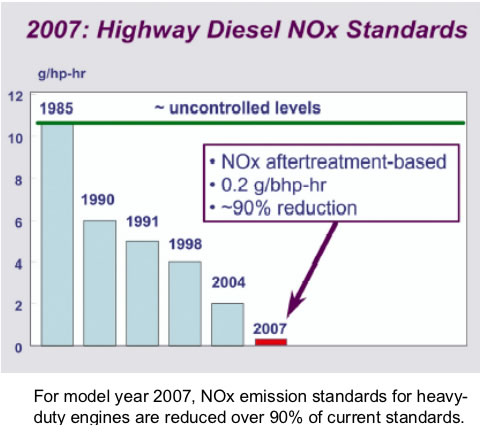
However, even at the 2007 levels the WHO and the EPA are pronouncing the NOx to high. Furthermore, many diesel vehicles remain on the road for more than 20 years. The 2010 EPA regulations now require the addition of the urea filter requiring refilling of the urea on all new vehicles (shown below).
1.5. What are we doing now to reduce this threat to ourselves and our environment?
The sketch below show a modern after engine treatment to reduce both the particulates and the NOx. On the left is the Diesel Particulate Filter and its active regeneration mechanism. On the right is the urea filled filter (AdBlue is a trade name for the urea compound) in the Selective Catalytic Reduction (SCR) for NOx reduction.
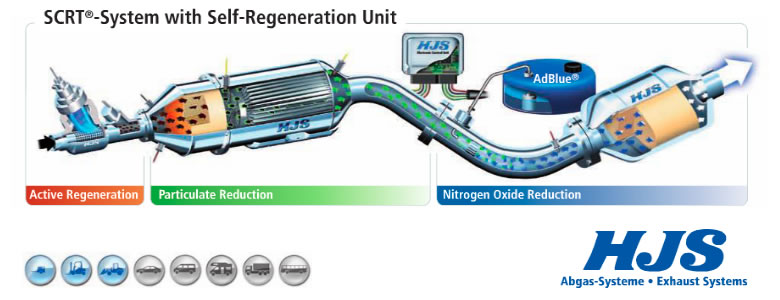
1.5.1 How does the NOx reduction work?
SCR is a method of converting harmful diesel oxides of nitrogen (NOx) emissions, by catalytic reaction, into benign nitrogen gas and water. SCR can deliver near-zero emissions of NOx, an acid rain and smog-causing pollutant and greenhouse gas, in modern highway clean diesel engines. The SCR system does not alter the design of the modern Common Rail Diesel (CRD) engine, therefore it can continue to deliver excellent fuel economy and durability. Rather, SCR provides emissions after-treatment well into the exhaust stack, in a way similar to the soot containment achieved by the Diesel Particulate Filter (DPF). SCR works by injecting Diesel Exhaust Fluid (DEF) , such as AdBlue, into the hot exhaust stack. DEF works in conjunction with the hot exhaust gases and catalyst to break NOx into two components of our normal atmosphere—water vapor and nitrogen.
The Process - How SCR Works
Engine: The NOx reduction process starts with an efficient CRD engine design that burns clean Ultra Low Sulfur Diesel (ULSD) and produces inherently lower exhaust emissions—exhaust that is already much cleaner due to leaner and more complete combustion.
Diesel Exhaust Fluid (DEF) tank and pump: Under the direction of the vehicle’s onboard computer, DEF is delivered in precisely metered spray patterns into the exhaust stream just ahead of the SCR converter.
SCR Catalytic Converter: This is where the conversion happens. Exhaust gases and an atomized mist of DEF enter the converter simultaneously. Together with the catalyst inside the converter, the mixture undergoes a chemical reaction that produces nitrogen gas and water vapor.
Control device: Exhaust gases are monitored via a sensor as they leave the SCR catalyst. Feedback is supplied to the main computer to alter the DEF flow if NOx levels fluctuate beyond acceptable parameters.
The AdBlue is a urea additive that must be added and used for each so many gallons of diesel fuel. The fraction needed per gal of diesel fuel for some vehicles will be added later. In general, it has been estimated that a quart is used for every 300 miles.
1.5.2. How do we reduce the quantity of the particulates?
Currently the only way to reduce the particulates emitted from a diesel engine is to capture them in a filter. A rendering of a diesel particulate filter is shown here. These are now mandated on all new vehicles in the US, but, by far, the majority of diesel vehicles on the road do not have them. If they do have them, they must be cleaned regularly. They are automatically cleaned by having the engine burn off the captured particles. But this requires fuel, and leads to emissions.
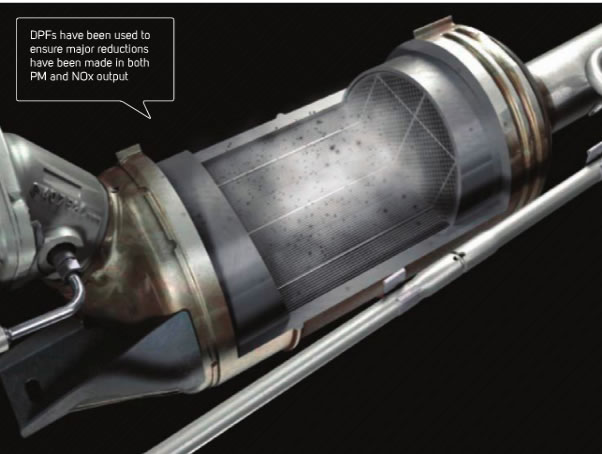
Of game changing importance will be to change from using diesel fuel altogether to achieve high mileage and torque, to using alcohols in similarly high compression engines, but with spark ignition. Alcohols emit almost no particulates. We discuss this below and on pages to be designated later. But first, we discuss health problems from using gasoline.
2. Gasoline Health Problems
2.1. Introduction
Gasoline has historically been spreading dummying lead all over the world for decades as it has added to gasoline and emitted through the vehicle's exhaust. In developed countries it has been prohibited for many years, but is still used in developing countries. It is used to boost octane rating. We review some of this history here.
In recent times, other chemicals have substituted for lead. One has been ethanol. Earlier MTBE was used, but it leaked into the ground water, and it a persistent smell, and some feared could cause health problems. MTBE is banned in the US, though still used in Europe.
As part of the oil industry's efforts to get off lead and to reduce tailpipe emissions, they have produced "reformulated gasoline". This contains benzene, toluene and xylene. All aromatics, and all bad for our health, but the worst is benzene.
2.2. Benzene
As part of the cocktail needed to replace the lead, benzene and other aromatics are used. We have a video on this site, here.
3. Ethanol (and methanol) can be used in high efficiency "diesel" engines, and all gasoline engines.
We do not need to use diesel fuel and compression ignition engines to achieve the high thermodynamic efficiencies of the current diesel engines. Furthermore we do not need to use gasoline either. Internal combustion engines, of both low and high compression can run on alcohols. A video outline of the history and current opportunities in on the video and slideshow page here.
3.1. Use of alcohols in high compression engines
The US Navy knew this fact in the early 1900's. The admiral of the US Navy writing to Henry Ford in 1916 said "
3.2. The largest contributor to increased food costs is the cost of oil
The chart below shows the correlation between the food price index and the oil price index. It is clear that from the start of the extensive use of corn ethanol as a fuel around 2005, that the correlation remains stronger than ever. This correlation shows that the high price of food is NOT related to the amount of corn used to produce ethanol.
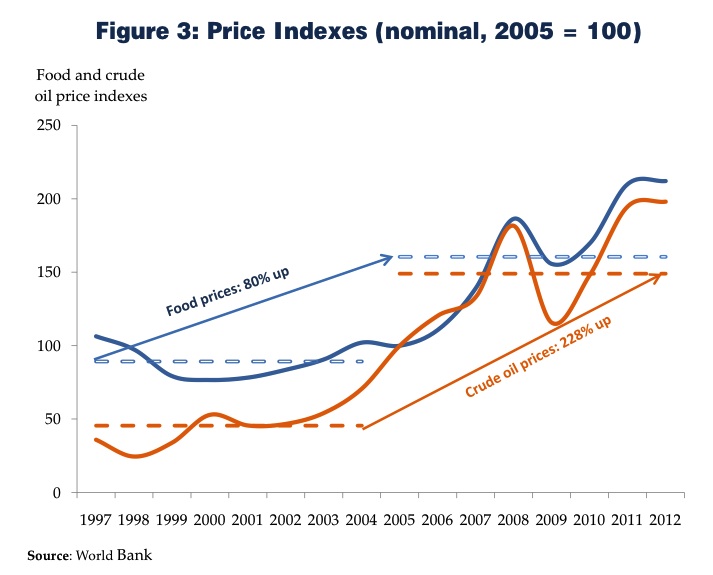
This is because the machinery farmers use to produce and distribute food is largely powered by diesels, which require diesel fuel, and of course diesel fuel comes from oil. Since essentially all farm machinery can run on ethanol (or methanol), as was the case in Henry Ford's day, and, of course, this can be done much better today. Simply doing the farming with a fuel derived from the crops, and their wastes, would break this strong correlation and reduce the cost of food worldwide.


